The AMD 2nd Gen Ryzen Deep Dive: The 2700X, 2700, 2600X, and 2600 Tested
by Ian Cutress on April 19, 2018 9:00 AM ESTCPU Rendering Tests
Rendering tests are a long-time favorite of reviewers and benchmarkers, as the code used by rendering packages is usually highly optimized to squeeze every little bit of performance out. Sometimes rendering programs end up being heavily memory dependent as well - when you have that many threads flying about with a ton of data, having low latency memory can be key to everything. Here we take a few of the usual rendering packages under Windows 10, as well as a few new interesting benchmarks.
All of our benchmark results can also be found in our benchmark engine, Bench.
Corona 1.3: link
Corona is a standalone package designed to assist software like 3ds Max and Maya with photorealism via ray tracing. It's simple - shoot rays, get pixels. OK, it's more complicated than that, but the benchmark renders a fixed scene six times and offers results in terms of time and rays per second. The official benchmark tables list user submitted results in terms of time, however I feel rays per second is a better metric (in general, scores where higher is better seem to be easier to explain anyway). Corona likes to pile on the threads, so the results end up being very staggered based on thread count.
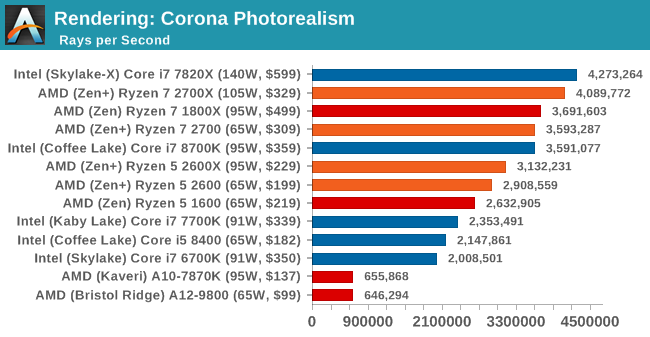
Blender 2.78: link
For a render that has been around for what seems like ages, Blender is still a highly popular tool. We managed to wrap up a standard workload into the February 5 nightly build of Blender and measure the time it takes to render the first frame of the scene. Being one of the bigger open source tools out there, it means both AMD and Intel work actively to help improve the codebase, for better or for worse on their own/each other's microarchitecture.
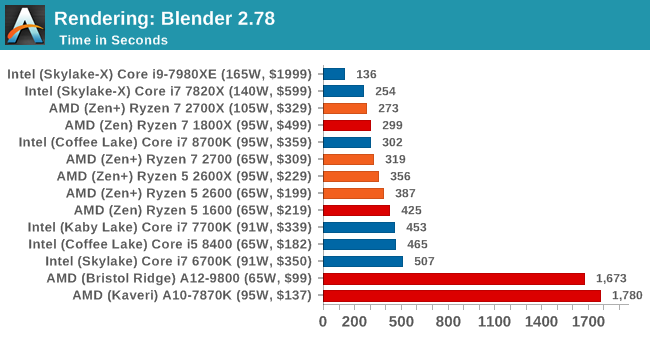
This is one multi-threaded test where the 8-core Skylake-based Intel processor wins against the new AMD Ryzen 7 2700X; the variable threaded nature of Blender means that the mesh architecture and memory bandwidth work well here. On a price/parity comparison, the Ryzen 7 2700X easily takes the win from the top performers. Users with the Core i7-6700K are being easily beaten by the Ryzen 5 2600.
LuxMark v3.1: Link
As a synthetic, LuxMark might come across as somewhat arbitrary as a renderer, given that it's mainly used to test GPUs, but it does offer both an OpenCL and a standard C++ mode. In this instance, aside from seeing the comparison in each coding mode for cores and IPC, we also get to see the difference in performance moving from a C++ based code-stack to an OpenCL one with a CPU as the main host.

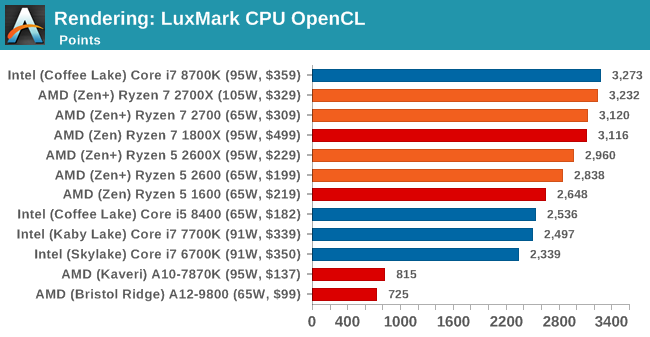
POV-Ray 3.7.1b4: link
Another regular benchmark in most suites, POV-Ray is another ray-tracer but has been around for many years. It just so happens that during the run up to AMD's Ryzen launch, the code base started to get active again with developers making changes to the code and pushing out updates. Our version and benchmarking started just before that was happening, but given time we will see where the POV-Ray code ends up and adjust in due course.
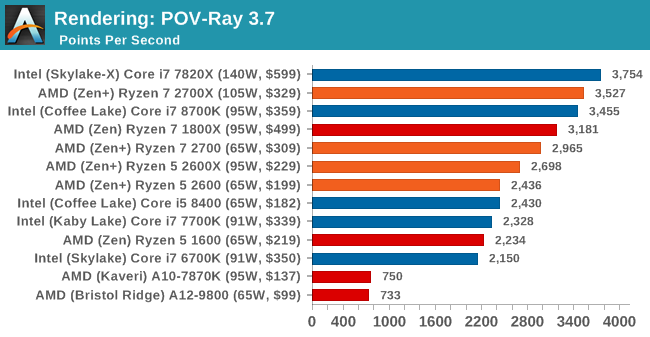
Cinebench R15: link
The latest version of CineBench has also become one of those 'used everywhere' benchmarks, particularly as an indicator of single thread performance. High IPC and high frequency gives performance in ST, whereas having good scaling and many cores is where the MT test wins out.
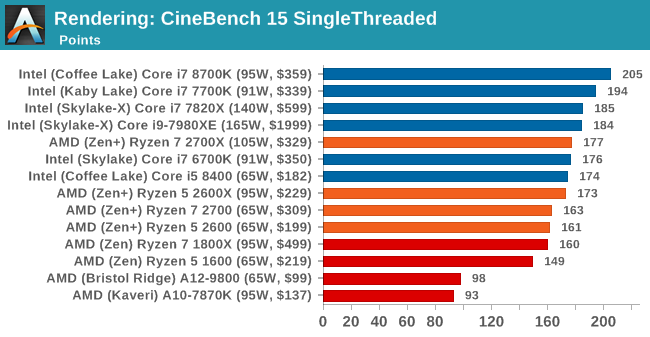
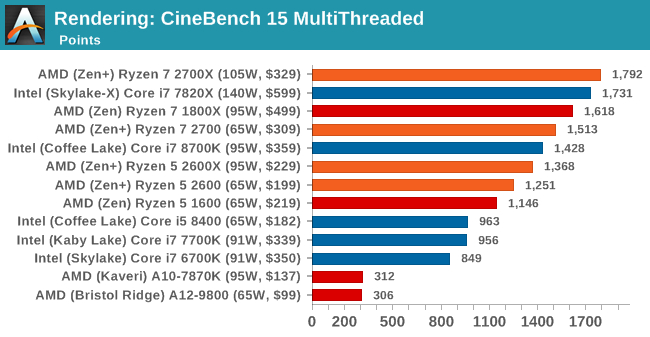
Intel is still the single thread champion in benchmarks like CineBench, but it would appear that the Ryzen 7 2700X is now taking the lead in the multithreaded test.










545 Comments
View All Comments
ACE76 - Thursday, April 19, 2018 - link
AMD is going to unleash some serious tech next year with Ryzen 2 on 7nm...this is just a refresh of the original Ryzen...the real deal will be next April/May...Intel is in for a rough ride.tmiller02 - Thursday, April 19, 2018 - link
the patches are the difference.. which everyone should do on intel machines.. the fact is they came with a performance hit! AMD is now leading the pack... security over performance any day!Dr. Swag - Thursday, April 19, 2018 - link
I've seen other sites do their tests with the patches. I'm just not certain if they went back and rested older cpus or not...Lolimaster - Thursday, April 19, 2018 - link
You can be sure most didn't.fallaha56 - Thursday, April 19, 2018 - link
Most didn’t patchLook at techradar who did -they too are showing massive losses for Intel
Luckz - Monday, April 23, 2018 - link
Techradar's review is some form of manipulation. They don't even show the test system specs for the comparison scores. In their 8700K review they wrote the CPU hit 76° for them at stock and 87° OC; in the 2700X review they wrote that the 8700K only went up to 52°(!!!). That CPU literally had its handbrake™ pulled.Ranger1065 - Thursday, April 19, 2018 - link
Thank you for an informative and timely review.T1beriu - Thursday, April 19, 2018 - link
What workload was used during per core power consumption tables?Ian Cutress - Thursday, April 19, 2018 - link
Prime95Luckz - Monday, April 23, 2018 - link
Assuming that means the non-AVX version, with that tool it makes sense to clarify.